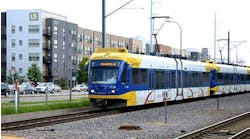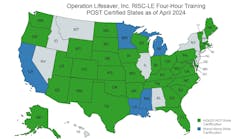Construction began Tuesday morning on the Crenshaw/LAX Transit Project, an 8.5-mile, $2.058-billion light-rail line that will run between the Metro Expo and Green lines and is expected to open in 2019. The project will also bring Metro Rail closer to Los Angeles International Airport.
The groundbreaking bought together top officials from federal, state and local government, including U.S. Transportation Secretary Anthony Foxx and California Sen. Barbara Boxer.
The event was held at the intersection of Crenshaw and Exposition boulevards, where the first of the project’s three underground stations will be built. Demolition of some existing structures will be among the first work done, with heavy construction expected to begin this spring.
“Thousands of hard-working families and seniors living in Crenshaw depend on public transportation every day to get to work, to school, and to obtain medical care,” said Foxx. “Bringing light rail to this community will create jobs, spur local economic development and make it easier than ever for residents to access downtown Los Angeles and beyond.”
The new Crenshaw/LAX Transit Project will be the first rail line to serve Crenshaw Boulevard and the city of Inglewood since the streetcars of the Los Angeles Rail Line (known as the “Yellow Cars”) stopped running in 1955. In some places, the new light rail line will use the old alignment for the streetcars.
“The Crenshaw Line is a top priority for me because it will provide a crucial transportation link, create over 18,000 jobs, help connect communities, reduce air pollution, and provide economic development and economic opportunities,” said Boxer, who is chairman of the Senate Environment and Public Works Committee.
The new light-rail line will serve the Crenshaw Corridor, Inglewood, Westchester and the area around Los Angeles International Airport with eight stations, a maintenance facility and park-and-ride lots.
“Los Angeles Metro’s Crenshaw/LAX Transit Project is about making a long-term investment in South Los Angeles’ infrastructure that will benefit Angelinos for generations to come,” said Congresswoman Karen Bass. “This project is about generating over 18,000 jobs over the next six years for the Southern California economy as we work to climb out of the Great Recession. This project is about providing real work now to people who need it, with over half of the current jobs being filled by economically disadvantaged workers, and many of these jobs are currently being filled by African American workers. And this project is about time. For years we have promised a real change that will ease congestion on L.A.’s streets and put real dollars into South Los Angeles that allow people who live, work and play here a real choice to get around our great city, and the Crenshaw/LAX Project puts shovels where our rhetoric had been.”
"A world class Los Angeles needs a world class transit system that reduces traffic and connects our neighborhoods," said Los Angeles Mayor and Metro Board Vice Chair Eric Garcetti. "The Crenshaw/LAX Corridor light rail will be a vital link in our regional transportation network and will serve thousands of residents in Crenshaw, Inglewood and Westchester and people traveling to and from LAX."
“Today we celebrate the beginning of construction of a new 8.5-mile light rail project along the Crenshaw corridor that connects the Expo Line with the Metro Green Line completing a vital north/south piece of the LA County Metro Rail system,” said Metro Board Chair Diane DuBois. “Not only will this project improve mobility but it will deliver economic opportunity to communities that have been passed by progress enjoyed elsewhere.
In a separate project, planners at both Metro and Los Angeles World Airports officials are working together on the Airport Metro Connector that will link the Crenshaw/LAX Line to the LAX terminals via light rail, a people mover or a combination of the two.
“This day has been a long time coming,” said Los Angeles County Supervisor Mark Ridley-Thomas. “The Crenshaw/LAX Transit Project not only will provide much needed transportation to our airport, but it will create thousands of jobs over the course of construction and link the Crenshaw District to the rest Los Angeles. That’s something to celebrate.”
The eight new stations will be located at Expo/Crenshaw (underground), Crenshaw/Martin Luther King (underground), Crenshaw/Vernon in Leimert Park (underground), Crenshaw/Slauson, Florence/West, Florence/La Brea (downtown Inglewood), Florence/Hindry and Aviation/Century (LAX).
The Crenshaw/LAX Transit Project is one of 12 major transit projects funded by Measure R, the half-cent sales tax approved by 68 percent of Los Angeles County voters in 2008. The project is also receiving other state and local funds.
The federal Transportation Infrastructure Finance and Innovation Act (TIFIA) program, which provides credit assistance for infrastructure projects and is overseen by the U.S. Department of Transportation, provided a $545.9-million loan toward the Crenshaw/LAX Line. The project also is expected to receive approximately $130 million in other funds from the DOT and the Federal Transit Administration.
The new light-rail line will be built by Walsh/Shea Corridor Constructors, a joint venture between Walsh Construction and J.F. Shea Company (WSCC). WSCC expects to first begin construction of the Crenshaw/Exposition underground station, where the Tunnel Boring Machines will be lowered into the ground and then begin working south to 48th street, where the tracks will rise to street level.
About 55 percent of the Crenshaw/LAX Line will be separated from roadways with the tracks either in a tunnel, in a trench or an aerial structure. That’s far more than tracks serving the existing Blue Line, Expo Line and Gold Line. The great majority of those rail lines run at street level.


